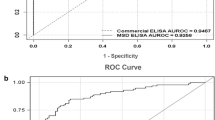Abstract
Background
In this study, we investigated the influence of hematuria on the performance of the bladder tumor antigen (BTA) tests in a clinical cohort and in an experimental model.
Materials and methods
Urine samples from a cohort of 126 subjects (64 with BCa and 62 controls) were analyzed by ELISA for hemoglobin and BTA. The experimental model involved the spiking of urine with blood from the same subject, and hemoglobin, red blood cell count, and BTA levels (BTA stat© and BTA-TRAK©). BTA-TRAK© analyses were also performed on serum samples obtained from 40 subjects (20 with confirmed with BCa).
Results
In the 126 subject cohort, correlation between hemoglobin and BTA was 0.732. Of the 64 BCa samples, 72 % had a positive BTA assay, but 47 % of controls were also positive. The sensitivity and specificity of BTA to detect BCa was 72 and 53 %, respectively. Hematuria, measured by urinary hemoglobin, was a better indicator of BCa with 75 % sensitivity and 90 % specificity. Spiking of BTA-negative urine samples with as little as 1 μl/10 ml was enough to produce a positive BTA test. High levels of BTA were found equally in the serum of subjects with or without BCa (mean BTA levels 355,159 vs. 332,329 U/ml, respectively).
Conclusions
Rather than detecting a bladder tumor antigen, urinary BTA assays may be measuring serum cFH introduced by bleeding, a common presenting factor in BCa subjects. The presence of hematuria in subjects without malignant disease can result in false-positive BTA assays.

Similar content being viewed by others
References
Heicappell R, Wettig IC, Schostak M, Müller M, Steiner U, Sauter T, Miller K (1999) Quantitative detection of human complement factor H-related protein in transitional cell carcinoma of the urinary bladder. Eur Urol 35(1):81–87
Kinders R, Jones T, Root R, Bruce C, Murchison H, Corey M, Williams L, Enfield D, Hass GM (1998) Complement factor H or a related protein is a marker for transitional cell cancer of the bladder. ClinCancer Res 4(10):2511–2520
Thomas L, Leyh H, Marberger M, Bombardieri E, Bassi P, Pagano F et al (1999) Multicenter trial of the quantitative BTA TRAK assay in the detection of bladder cancer. Clin Chem 45:472–477
Mahnert B, Tauber S, Kriegmair M, Nagel D, Holdenrieder S, Hofmann K, Reiter W, Schmeller N, Stieber P (2003) Measurements of complement factor H-related protein (BTA-TRAK assay) and nuclear matrix protein (NMP22 assay)—useful diagnostic tools in the diagnosis of urinary bladdercancer? ClinChem Lab Med 41(1):104–110
Ellis WJ, Blumenstein BA, Ishak LM, Enfield DL (1997) Clinical evaluation of the BTA TRAK assay and comparison to voided urine cytology and the Bard BTA test in patients with recurrent bladder tumors. The Multi Center Study Group. Urology 50(6):882–887
Thomas L, Leyh H, Marberger M, Bombardieri E, Bassi P, Pagano F, Pansadoro V, Sternberg CN, Boccon-Gibod L, Ravery V, Le Guludec D, Meulemans A, Conort P, Ishak L (1999) Multicenter trial of the quantitative BTA TRAK assay in the detection of bladder cancer. Clin Chem 45(4):472–477
Fluss R, Faraggi D, Reiser B (2005) Estimation of the Youden Index and its associated cutoff point. Biometrical J 47(4):458–472
Rosser CJ, Liu L, Sun Y, Villicana P, McCullers M, Porvasnik S et al (2009) Bladder cancer-associated gene expression signatures identified by profiling of exfoliated urothelia. Cancer Epidemiol Biomarkers Prev 18:444–453
Edgar R, Domrachev M, Lash AE (2002) Gene Expression Omnibus: NCBI gene expression and hybridization array data repository. Nucleic Acids Res 30:207–210
Urquidi V, Goodison S, Kim J, Chang M, Dai Y, Rosser CJ (2012) MDVEGF, CA9 and angiogenin as a urinary biomarker for bladder cancer detection. Urol 79(5):1185.e1–6
Oge O, Kozaci D, Gemalmaz H (2002) The BTA stat test is nonspecific for hematuria: an experimental hematuria model. J Urol 167(3):1318–1319 Discussion 1319–1320
Kinders RJ, Landicho H (2002) Re: the BTA stat test is nonspecific for hematuria: an experimental hematuria model. J Urol 168(6):2556
Lüdecke G, Pilatz A, Hauptmann A, Bschleipfer T, Weidner W (2012) Comparative analysis of sensitivity to blood in the urine for urine-based point-of-care assays (UBC rapid, NMP22 BladderChek and BTA-stat) in primary diagnosis of bladder carcinoma. Interference of blood on the results of urine-based POC tests. Anticancer Res 32(5):2015–2018
Hennenlotter J, Huber S, Todenhöfer T, Kuehs U, Schilling D, Aufderklamm S, Gakis G, Schwentner C, Stenzl A (2011) Point-of-care tests for bladder cancer: the influencing role of hematuria. Adv Urol 2011:937561
Acknowledgments
This work was supported by the research grants from the Florida Department of Health James and Esther King Team Science Award 10KT-01 (CJR), the National Cancer Institute RO1 CA116161 (SG), and the Flight Attendant Medical Research Institute (CJR).
Conflict of interest
The authors declare that they have no conflict of interest.
Author information
Authors and Affiliations
Corresponding author
Rights and permissions
About this article
Cite this article
Miyake, M., Goodison, S., Rizwani, W. et al. Urinary BTA: indicator of bladder cancer or of hematuria. World J Urol 30, 869–873 (2012). https://doi.org/10.1007/s00345-012-0935-9
Received:
Accepted:
Published:
Issue Date:
DOI: https://doi.org/10.1007/s00345-012-0935-9




